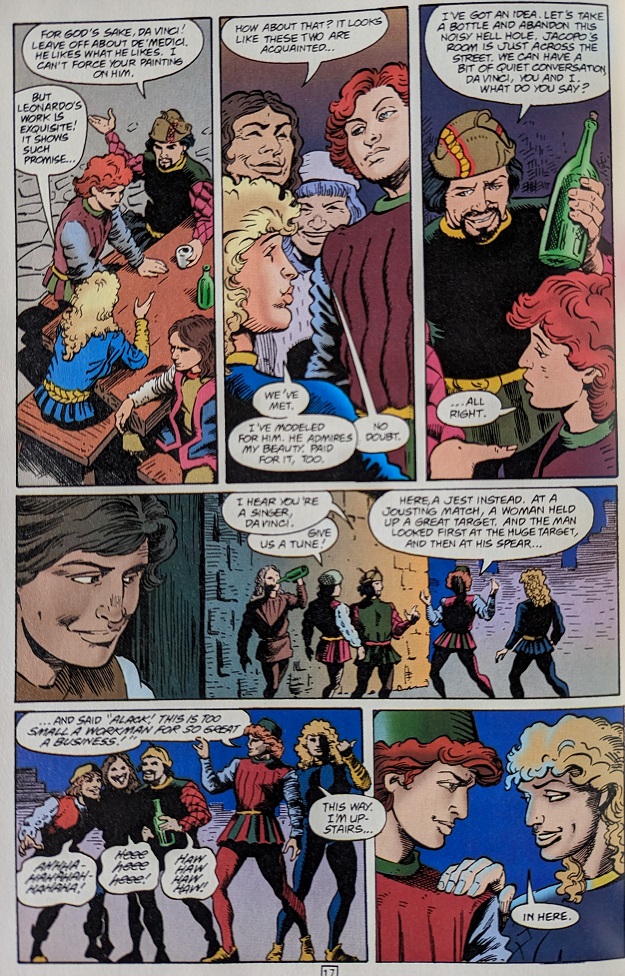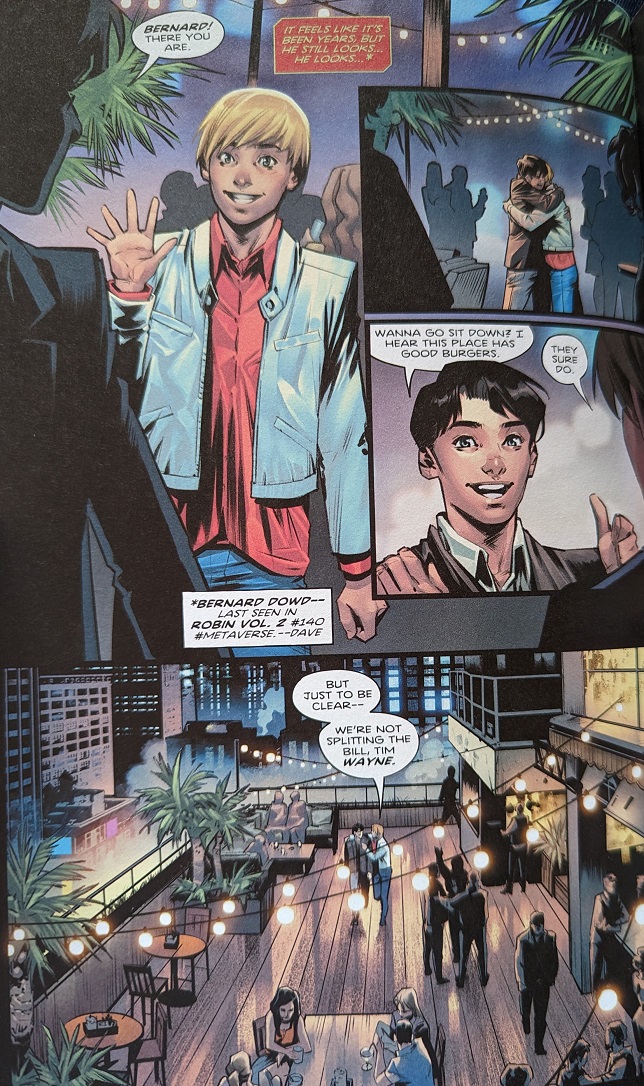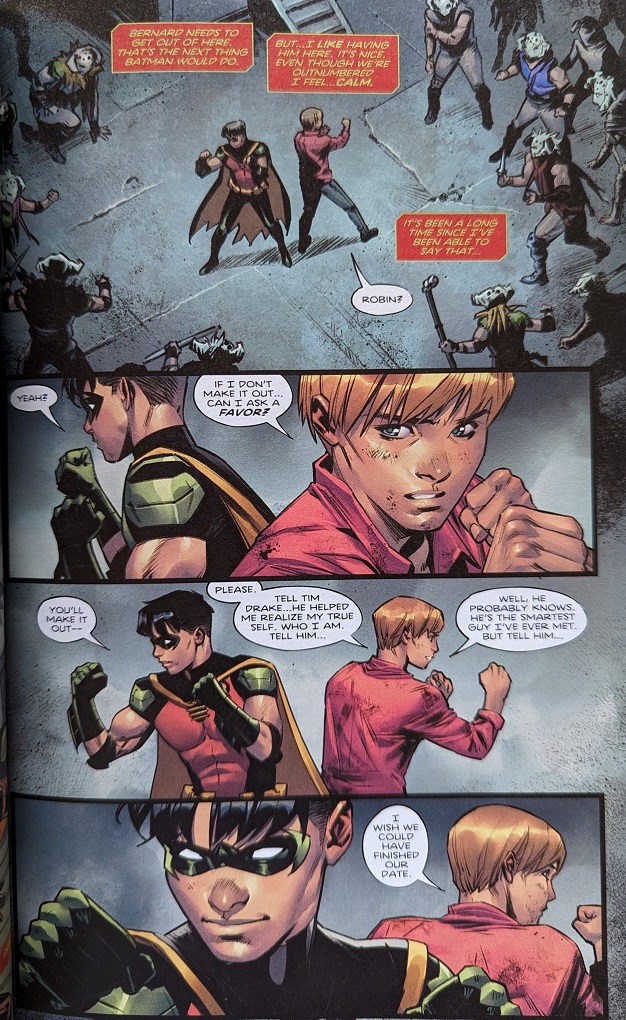In Vertigo’s early days, most projects were connected to pre-existing intellectual property. Maybe at the beginning not that many risks were taken but Chiaroscuro: the Private Lives of Leonardo da Vinci is a magnificent example of audacity. Thanks to legendary editor Karen Burger, this project became a reality even though it had everything against it. This wasn't a superhero story reinterpreted for mature audiences, this wasn't part of the Sandman universe or a Hellblazer miniseries. It was different to everything else being published at the time in the US.
In the American market very few historical comics existed, in contrast with Europe. Chiaroscuro represents that breaking point where everyone realizes that Vertigo can be many things as an imprint, not just the slightly edgier, more mature-audience related reinterpretation of DC characters. Vertigo would be a place for completely innovative stories, by new and courageous creative teams: “From the moment I first encountered the salacious, hedonistic, entirely charismatic character of Salai, I was hooked as it seems was Leonardo. Of all the mysteries surrounding DaVinci -and there are many- none seems more intriguing to me than the strange affection he held for this young man, since many of the surprising revelations in Chiaroscuro are based on historical research”, explains co-editor Alisa Kwitney.
 |
| Stephen John Phillips & Richard Brunning |
‘Salai’ was actually a nickname in Italian, meaning ‘little devil’. According to David Rawson: “A good deal of history is simply best guess agreement among scholars, often ultimately deriving from a single source itself imprecise. From what is held true, we speculated about what might be true regarding Da Vinci's motivations and feelings. Where no one could reasonably prove us wrong, we invented. I will say this, though: folks are going to be hard put to identify what is real, what is supposition and what is invention. Often the stranger stuff is real”. Certainly, the amount of historical research involved in this project is impressive.
Artist Chas Truog explains his approach: “Those are the comics I'd like to do. To a larger extent, Chiaroscuro has been an answer to that wish. But it's been said that we have to be careful what we wish for, because we might get it. Chiaroscuro has also been a lot more work than the average comics project. The art style requires more time to draw (forget about doing a page a day!), and then there's research: you might draw someone standing in a doorway, get the costume right, and then realize you have no idea what a doorknob looks like in 1500. What eating utensils do they use? Is that suit of armor from the right period?”. After working with Grant Morrison in the groundbreaking Animal Man, Truog proves to be the right artist for a Renaissance comic.
The private life of Leonardo da Vinci is told by his protégé Salai, who is posing nude for a sculptor that remains unseen to the reader. Salai is a young man who is adopted by the Maestro when he is a 10-year-old child; Salai grows up in the court of Milan, along with the da Vinci. The story isn’t told in chronological order but rather in the order Salai remembers things. We see how Salai feels from the beginning, how much he revered Leonardo as a child, in those early years, for Salai, Leonardo was this unreachable idol, this larger than life figure. But when Salai becomes a teenager, he starts to rebel against the Maestro. He becomes even more unpredictable and disobedient than ever, until he no longer admires da Vinci; in fact, he starts despising the Maestro.
 |
| ...bisexual? |
Salai’s entire existence is defined by his companionship with Leonardo, he’s always lived under his shadow and now he must discover who he truly is, on his own, and so he embarks on a journey of at sexual escapades both with men and women, while he tries to understand the mechanisms of power within the court. In “The Black Room” (originally published in Chiaroscuro # 2, August 1995), Salai loses his virginity at the hands of a selfish man who will abandon him later. “After the bit where Leonardo spurns Salai's sexual advances, we knew Salai was going to give himself over to someone else in retribution”, explains Pat McGreal. Salai is always seeking revenge; he is frustrated with Leonardo but at the same time confused; he knows Leonardo feels attracted to him but he doesn't understand why this doesn't end up in a physical encounter. Perhaps it's because Leonardo, as much as he finds the boy attractive and beautiful, sees him more as an adopted son. It's impossible to know for sure what really happened between them, even if they ended up having sex there would be no historical records about that.
In “Greater than light” (Chiaroscuro # 1, July 1995), we get to see a historical moment, when Leonardo and Michelangelo are both tasked to produce a mural in Florence. Here and in real life as well, they were both unable to complete this project, which would have been the ultimate artistic competition: the two greatest masters of art in the history of mankind, the two greatest men of the Renaissance, side by side, a mural versus another mural. Alas, this never came to happen, but that moment is represented here, and we see how everyone in Florence is just so curious about what the murals will look like, and they keep asking questions to Salai, because he is the only one who is close to Leonardo and to Michelangelo.
 |
| Firenze |
In “Clearly in Dreams” (Chiaroscuro # 3, September 1995) and “Dispero” (Chiaroscuro # 4, October 1995), Leonardo is struggling as a young artist; he works in a workshop for Verrochio and he's having a hard time to find the patronage that he needs to become the artist that he knows he can be. After a party, he ends up visiting a young man, and there is an intimate encounter between them. Shortly after that, Leonardo is accused of committing sodomy, a very serious crime, and he is sent to prison. Fortunately for him, a cousin of Lorenzo de Medici intervenes and he's able to escape the death penalty. After that, of course, Leonardo becomes more reclusive and more careful about his private life.
 |
| Leonardo da Vinci & Salai |
Botticelli and other friends are trying to tell Leonardo that he has no future with the Medici family and the Maestro understands that he needs to go to Milan, to work for Ludovico Sforza. Once he goes there, his brilliant career starts and he stays there for 18 years. What was supposed to be one of his greatest accomplishments, which was an equestrian sculpture (the greatest in the world at the time), had suffered may many delays. I knew about all of this because I'm a big fan of Leonardo da Vinci and I have read a couple of biographies, and yet it's especially refreshing to see all of this unfolding in the pages of a comic book. We see the progress of this project, and how Leonardo was so passionate about it and how it gets delayed over and over again, it's so frustrating for him. At the end, of course, we see the fall of Milan, as they are conquered by the French, and suddenly everything changes. Leonardo loses absolutely everything. He no longer has a powerful noble man supporting him and so with very few belongings he has to flee to Mantua. In this moment, we see the complex relationship between the Maestro and the protégé, between the adult and the young man, and we see how Salai is able to manipulate Leonardo.
________________________________________________________________________________________________________
________________________________________________________________________________________________________
En los primeros días de Vertigo, la mayoría de los proyectos estaban conectados a alguna propiedad intelectual preexistente. Quizás al principio no se corrieron muchos riesgos pero Claroscuro: las vidas privadas de Leonardo da Vinci es un magnífico ejemplo de audacia. Gracias a la legendaria editora Karen Burger, este proyecto se hizo realidad a pesar de que tenía todo en su contra. Esta no era una historia de superhéroes reinterpretada para audiencias maduras, no era parte del universo de Sandman o una miniserie de Hellblazer. Era diferente a todo lo que estaba publicando en ese momento en los Estados Unidos.
En el mercado estadounidense existían muy pocos cómics históricos, a diferencia del europeo. claroscuro representa ese punto de quiebre en el que todos se dan cuenta de que Vertigo puede ser muchas cosas como un sello editorial, no sólo la reinterpretación de personajes de DC, con tono atrevido y maduro. Vertigo sería un lugar para historias completamente innovadoras, por equipos creativos nuevos y valientes: “Desde el momento en que me encontré por primera vez con el personaje lascivo, hedonista y completamente carismático de Salai, y parece que igual le pasó a Leonardo. De todos los misterios que rodean a DaVinci -y son muchos- ninguno me parece más intrigante que el extraño cariño que le tenía a este joven, ya que muchas de las sorprendentes revelaciones en Claroscuro se basan en investigaciones históricas”, explica la coeditora Alisa Kwitney.
 |
| Il Cenacolo |
'Salai' era en realidad un apodo en italiano, que significaba 'diablillo'. Según David Rawson: “Una gran parte de la historia es simplemente el mejor acuerdo de conjeturas entre los académicos, que a menudo se deriva en última instancia de una fuente única en sí misma imprecisa. A partir de lo que se considera cierto, especulamos sobre lo que podría ser cierto con respecto a las motivaciones y sentimientos de Da Vinci. Donde nadie podía probar razonablemente que estábamos equivocados, inventamos. Sin embargo, diré esto: a la gente le resultará difícil identificar qué es real, qué es una suposición y qué es una invención. A menudo, las cosas más extrañas son reales”. Ciertamente, la cantidad de investigación histórica involucrada en este proyecto es impresionante.
 |
| Salai's first sexual experience / la primera experiencia sexual de Salai |
El artista Chas Truog explica su enfoque: “Esos son los cómics que me gustaría hacer. En mayor medida, Claroscuro ha sido una respuesta a ese deseo. Pero se ha dicho que tenemos que tener cuidado con lo que deseamos, porque podemos conseguirlo. Claroscuro también ha sido mucho más trabajo que el proyecto promedio de cómics. El estilo artístico requiere más tiempo para dibujar (¡olvídate de hacer una página al día!), y luego está la investigación: podrías dibujar a alguien parado en una puerta, acertar con el traje y luego darte cuenta de que no tienes idea de cómo se ve un picaporte en 1500. ¿Qué utensilios para comer usan? ¿Es esa armadura del período correcto?”. Después de trabajar con Grant Morrison en el rompedor Animal Man, Truog demuestra ser el artista adecuado para un cómic renacentista.
 |
| Leonardo da Vinci's last days in Milan / los últimos días de Leonardo da Vinci en Milán |
La vida privada de Leonardo da Vinci es contada por su protegido Salai, quien posa desnudo para un escultor que permanece oculto para el lector. Salai es un joven que fue adoptado por el Maestro cuando era un niño de 10 años; Salai crece en la corte de Milán, junto con da Vinci. La historia no se cuenta en orden cronológico, sino en el orden en que Salai recuerda las cosas. Vemos cómo se siente Salai desde el principio, cuánto reverenciaba a Leonardo cuando era niño, en esos primeros años, para Salai, Leonardo era este ídolo inalcanzable, esta figura más grande que la vida. Pero cuando Salai se convierte en un adolescente, comienza a rebelarse contra el Maestro. Se vuelve aún más impredecible y desobediente que nunca, hasta que ya no admira a da Vinci; de hecho, comienza a despreciar al Maestro.
Toda la existencia de Salai se define por acompañar a Leonardo, siempre ha vivido bajo su sombra y ahora debe descubrir quién es él realmente, por sí mismo, y así se embarca en un travesía de exabruptos sexuales tanto con hombres como con mujeres, mientras trata de entender los mecanismos de poder dentro de la corte. En “La habitación negra” (publicado originalmente en Chiaroscuro # 2, agosto de 1995), Salai pierde su virginidad a manos de un hombre egoísta que lo abandonará más tarde. “Después de la parte en la que Leonardo rechaza las insinuaciones sexuales de Salai, sabíamos que Salai se iba a entregar a otra persona como retribución”, explica Pat McGreal. Salai siempre está buscando venganza; está frustrado con Leonardo pero al mismo tiempo confundido; sabe que Leonardo se siente atraído por él pero no entiende por qué esto no termina en un encuentro físico. Tal vez sea porque Leonardo, por mucho que encuentra al adolescente atractivo y hermoso, lo ve más como un hijo adoptivo. Es imposible saber con certeza qué sucedió realmente entre ellos, incluso si hubiesen terminado teniendo relaciones sexuales, no habría registros históricos al respecto.
 |
| Botticelli, Leonardo da Vinci & Jacopo |
En “Más grande que la luz” (Chiaroscuro # 1, julio de 1995), podemos ver un momento histórico, cuando Leonardo y Miguel Ángel tienen la tarea de producir un mural en Florencia. Aquí y en la vida real, ambos fueron incapaces de completar este proyecto, que habría sido la competencia artística definitiva: los dos más grandes maestros del arte en la historia de la humanidad, los dos más grandes hombres del Renacimiento, uno al lado del otro, un mural versus otro mural. Por desgracia, esto nunca fue finiquitado, pero ese momento está representado aquí, y vemos cómo todos en Florencia tienen tanta curiosidad sobre cómo se verán los murales, y le siguen haciendo preguntas a Salai, porque él es el único cercano a Leonardo y a Miguel Ángel.
 |
| Leonardo da Vinci in prison / Leonardo da Vinci en prisión |
En “Claramente en sueños” (Chiaroscuro # 3, setiembre de 1995) y “Desespero” (Chiaroscuro # 4, octubre de 1995), Leonardo es un joven artista en aprietos; trabaja en un taller para Verrochio y le cuesta encontrar el patrocinio que necesita para convertirse en el artista que sabe que puede ser. Después de una fiesta, acaba visitando a un joven, y se produce un encuentro íntimo entre ambos. Poco después, Leonardo es acusado de cometer sodomía, un delito muy grave, y es enviado a prisión. Afortunadamente para él, interviene un primo de Lorenzo de Medici y logra escapar de la pena de muerte. Después de eso, por supuesto, Leonardo se vuelve más solitario y más cuidadoso con su vida privada.
Botticelli y otros amigos intentan decirle a Leonardo que no tiene futuro con la familia Medici y el Maestro entiende que necesita ir a Milán a trabajar para Ludovico Sforza. Una vez que va allí, comienza su brillante carrera y permanece allí durante 18 años. Lo que se suponía que sería uno de sus mayores logros, una escultura ecuestre (la más grande del mundo en ese momento), había sufrido muchos retrasos. Sabía todo esto porque soy un gran admirador de Leonardo da Vinci y he leído un par de biografías y, sin embargo, es especialmente refrescante ver todo esto desarrollándose en las páginas de un cómic. Vemos el progreso de este proyecto, y cómo a Leonardo le apasionaba tanto y cómo se retrasa una y otra vez, algo muy frustrante para él. Al final, por supuesto, vemos la caída de Milán, ya que son conquistados por los franceses, y de repente todo cambia. Leonardo lo pierde absolutamente todo. Ya no tiene a un noble poderoso que lo apoye y con muy pocas pertenencias tiene que huir a Mantua. En ese momento, vemos la compleja relación entre el Maestro y el protegido, entre el adulto y el joven, y vemos cómo Salai es capaz de manipular a Leonardo.




























